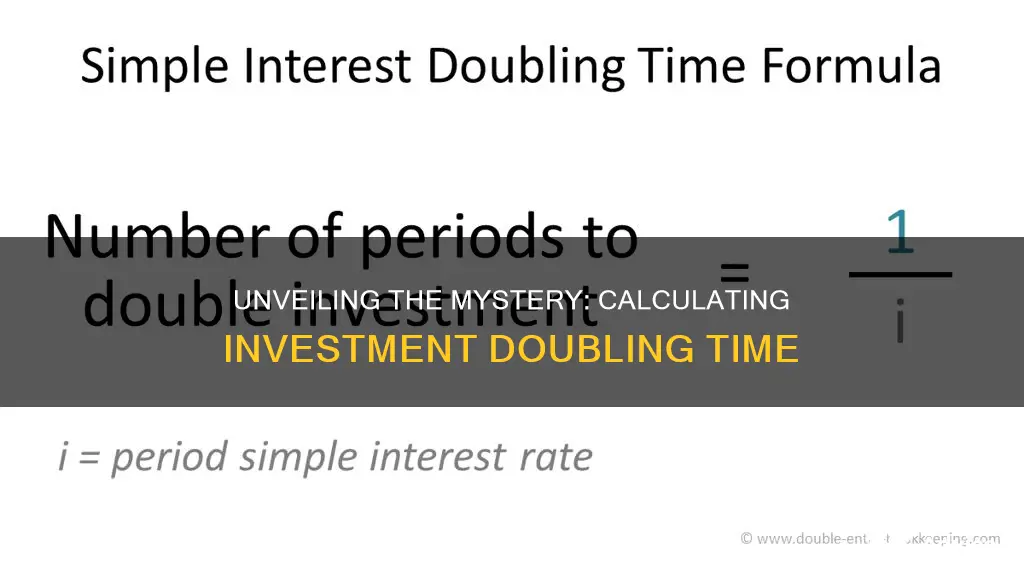
The Rule of 72 is a formula used to estimate the number of years required for an investment to double at a given annual rate of return. It is calculated by dividing 72 by the expected rate of return. For example, if you invest at a rate of 6%, your investment will double in 12 years (72/6 = 12). The Rule of 72 is a useful shortcut for investors to quickly gauge the potential returns on their investments. It is important to note that this rule assumes a constant rate of return over the life of the investment and is most accurate for rates of return between 5% and 12%.
| Characteristics | Values |
|---|---|
| Name of Rule | Rule of 72 |
| Use | To estimate the number of years required to double an investment at a given annual rate of return |
| Formula | Years to Double = 72 / Expected Rate of Return |
| Formula | Expected Rate of Return = 72 / Years to Double |
| Assumptions | The formula assumes a single average rate over the life of the investment |
| Assumptions | The formula assumes compounding interest, not simple interest |
| Accuracy | The rule is reasonably accurate for interest rates between 6% and 10% |
| Adjustments | For rates outside the 6-10% range, adjust by adding or subtracting 1 from 72 for every 3 points the interest rate diverges from 8% |

The Rule of 72
For example, if an investment scheme promises an 8% annual compounded rate of return, it will take approximately nine years (72 / 8 = 9) for the invested money to double.
The Annuity Trap: Why This Retirement Investment Could Cost You Dearly
You may want to see also

Compound interest
To understand how compound interest works, let's look at an example. Suppose you invest $1,000 at a 5% annual interest rate. At the end of the first year, you will have earned $50 in interest, and your total amount will be $1,050. In the second year, the 5% interest will be calculated on this new amount, so you will earn $52.50 in interest, and your total will become $1,102.50. This process continues, and your savings will grow at an increasing rate over time.
The rate at which your money grows depends on two main factors: the interest rate and the compounding frequency. The interest rate is the percentage by which your money grows each period, and the compounding frequency is how often the interest is calculated and added to your account. The more frequently your interest is compounded, the faster your money will grow. For example, if you have a 5% interest rate compounded monthly, your money will grow faster than if it is compounded annually.
To quickly estimate when your investment will double in value, you can use the Rule of 72. This rule states that you divide 72 by the expected annual rate of return. For example, if you expect a 6% annual rate of return, it will take approximately 12 years for your investment to double (72/6 = 12). The Rule of 72 is a simplified formula that assumes a constant rate of return and provides an approximate result.
It's important to note that compound interest can work for or against you, depending on whether you're saving or borrowing money. When you're investing or saving, compound interest is your friend, as it helps your money grow faster. However, when you're borrowing money, such as through a loan or credit card, compound interest can increase your debt faster than you might expect. Understanding compound interest is crucial for making informed financial decisions and achieving your financial goals.
Unveiling Rare Investing Opportunities
You may want to see also

Investment time frame
When it comes to investing, the time horizon is a crucial consideration. This refers to the length of time you plan to keep your money invested and is influenced by your investment goals and risk tolerance. Generally, short-term investments refer to those where you want to get your money back in less than a year, medium-term investments range from one to seven years, and long-term investments are those exceeding eight years, ideally more than ten.
The time horizon is important because it helps you adjust your investment objectives and the level of risk you're willing to take. For instance, if you want to double your money in one year, you'll need a 100% annual return, whereas a ten-year time frame would require a 7.2% return. Each investment product has its own recommended time horizon, which is designed to balance risk and returns.
It's important to be mindful of your time horizon when choosing investments. Short-term investments are typically focused on stability and protection, aiming to recover the invested amount even if it means lower returns. On the other hand, long-term investments can accommodate more risk or potential returns. This is because you have more time to correct mistakes and adjust your risk as the time horizon progresses.
The Rule of 72 is a useful formula for estimating how long it will take for your money to double at a given annual rate of return. It's a simplified formula that works well for interest rates between 6% and 10%. To use the rule, divide 72 by the expected annual rate of return. For example, if you expect a 6% annual rate of return, your investment will double in approximately 12 years (72/6 = 12).
Retirement Investing: Knowing When to Stop
You may want to see also

Risk and return
The Rule of 72 is a quick and useful formula that can be used to estimate the number of years required for an investment to double at a given annual rate of return. It can also be used to calculate the annual rate of compounded return from an investment, given the number of years it will take to double.
The formula is: Years To Double = 72 / Expected Rate of Return, or Expected Rate of Return = 72 / Years To Double.
For example, if an investment promises an 8% annual compounded rate of return, it will take approximately 9 years (72 / 8 = 9) to double the money invested.
The Rule of 72 is a simplified formula that provides a reasonably accurate estimate. To get the exact figure, a more complex logarithmic equation would need to be used.
Now, when it comes to risk and return, the risk-return tradeoff principle states that potential returns rise with an increase in risk. This means that low levels of uncertainty are associated with low potential returns, while high levels of uncertainty or risk are linked to high potential returns. According to this principle, an investor who is willing to accept a higher risk of losses can expect higher profits.
There are several ratios that can be used to calculate and assess risk and return. These include the alpha ratio, which measures excess returns on an investment above a benchmark return, the beta ratio, which shows the correlation between a stock and the benchmark that determines the overall market, and the Sharpe ratio, which helps determine whether the investment risk is worth the reward.
Additionally, time plays a crucial role in determining the appropriate levels of risk and reward. For example, long-term investments are generally considered more resilient to market downturns, as investors have more time to recover from losses. On the other hand, short-term investments have a higher risk proposition.
It is important for investors to understand their risk profile and risk tolerance before making investment decisions. Diversification of investments across different asset classes can also help to lower the overall risk of a portfolio.
Flipping Houses: Invest in Renovations
You may want to see also

Rate of return
A rate of return (RoR) is the net gain or loss of an investment over a specified time period, expressed as a percentage of the investment's initial cost. In other words, the rate of return is the gain or loss compared to the cost of an initial investment. When the RoR is positive, it is considered a gain, and when it is negative, it reflects a loss on the investment. The formula to calculate the RoR is:
For example, if you invest $1,000 for 1 year at a rate of return of 10%, then your investment would be worth $1,100 at the end of the one-year period, before subtracting expenses. Thus, your gain would be $100, which is 10% of your initial investment of $1,000.
The rate of return can be applied to any investment vehicle, from stocks and bonds to real estate and fine art. It is a useful metric for investors to assess the performance of different investments and determine which are the most attractive.
The simple rate of return does not take into account the effect of inflation over time. Therefore, it is sometimes referred to as a nominal rate of return. To account for the impact of inflation, we can calculate the real rate of return, which represents the net amount of discounted cash flows (DCF) received on an investment after adjusting for inflation.
Rule of 72
The Rule of 72 is a simplified formula that can be used to estimate the number of years required for an investment to double based on its rate of return. It is calculated by dividing 72 by the expected rate of return. For example, if an investment scheme promises an 8% annual compounded rate of return, it will take approximately 9 years (72 / 8 = 9) to double the invested money.
The Rule of 72 is a useful tool for mental calculations and is often taught to beginning investors as it is easy to understand and calculate. It provides a reasonably accurate estimate, but it is important to note that it is a simplification of a more complex logarithmic equation.
Invest or Repay Student Loans: Navigating the Financial Crossroads
You may want to see also
Frequently asked questions
The Rule of 72 is a formula used to estimate the number of years required for an investment to double at a given annual rate of return.
To calculate the number of years it will take for an investment to double, divide 72 by the expected rate of return. For example, if you expect a rate of return of 8%, it will take approximately 9 years for your investment to double (72/8 = 9).
Compound interest is calculated on both the initial principal and the accumulated interest of previous periods of a deposit. It is a huge perk of investing in the market since your interest earned is automatically reinvested, earning you even more.
The formula for calculating the time it takes for an investment to double is: Y = 72 / r, where Y is the number of years and r is the interest rate.
The Rule of 72 is a simplified formula that provides a quick estimate. For a more precise calculation, you can use the actual doubling time formula, which takes into account the compounding period and provides a more accurate result. Additionally, for daily or continuous compounding, using 69.3 in the numerator of the Rule of 72 formula can lead to a more accurate estimation.







